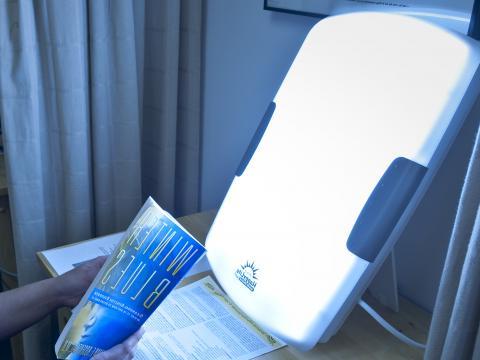
Research shows that light therapy, or exposure to full spectrum light, is an effective treatment for Seasonal Affective Disorder (SAD). Learn more about SAD.
Physicians, nurse practitioners, and mental health providers can diagnose SAD, based on criteria developed by the American Psychiatric Association. For an official diagnosis, you can make an appointment with a clinician at Health & Wellness or a Counselor at the Psychological and Counseling Services (PACS).
A diagnosis is not required to schedule a light therapy appointment.
How does it work?
Light therapy is usually administered using a light box. The light box encases a set of fluorescent bulbs or tubes that are covered with a plastic screen that helps block out potentially harmful ultraviolet (UV) rays. For optimal results, you sit directly in front of the light box (about 23 inches is optimal) with your eyes open. You can read, write, do homework, or just relax. The light box should sit at eye level at an angle to provide the most comfort and decrease glare.
Most studies show that about 75% of individuals who experience SAD feel improvement within a couple days to a few weeks. The most effective combination of intensity, duration, and timing varies from person to person, your medical or mental health provider can assist in guiding making appropriate adjustments.
- Daily sessions range from 15 minutes to 2 hours. Most sessions last 20-30 minutes, but can be built up over time.
- Please refrain from using cell phones or other electronic devices during the treatment.
- For most people, light therapy is best used in the morning, after first waking up.
Depending on how severely a person is affected, other treatments are helpful in combination with light therapy including psychotherapy, dietary changes, regular exercise, and the use of antidepressant medications.
Side effects
- Irritability
- Eyestrain
- Headaches
- Skin irritation (some medication can cause light sensitivity)
- Dry eyes
- Insomnia
Reducing the length of daily treatment or sitting further away from the light usually eliminates such effects. There is no research that shows exposure to light boxes can harm the retina or cause or accelerate eye disease.
What else can I do to take care of myself and increase the effectiveness of the lamps?
- Take daily walks outside
- Increase aerobic exercise particularly under bright lights
- Manage your stress
- Eat healthy
- Avoid exposure to bright light in the late evening, since this might shift timing of your sleep period
Make an Appointment
Light therapy appointments are available to the UNH community (students, UNH employees, and dependents over the age of 18).
A diagnosis is not required; however, we encourage you to make an appointment with a Health & Wellness clinician by calling (603) 862-2856, or a counselor at the UNH Psychological and Counseling Services (PACS), if you feel you are struggling with winter blues.
- Call (603) 862-3823
- Online
Additional Resources
- Mayo Foundation for Medical Education and Research: Seasonal Affective Disorder
- National Institute of Mental Health: Seasonal Affective Disorder
